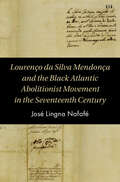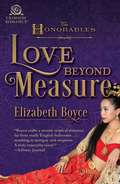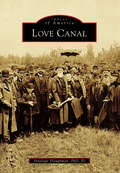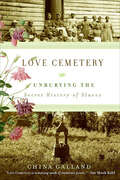- Table View
- List View
Lourenço da Silva Mendonça and the Black Atlantic Abolitionist Movement in the Seventeenth Century (Cambridge Studies on the African Diaspora)
by José Lingna NafaféThis groundbreaking study tells the story of the highly organised, international legal court case for the abolition of slavery spearheaded by Prince Lourenço da Silva Mendonça in the seventeenth century. The case, presented before the Vatican, called for the freedom of all enslaved people and other oppressed groups. This included New Christians (Jews converted to Christianity) and Indigenous Americans in the Atlantic World, and Black Christians from confraternities in Angola, Brazil, Portugal and Spain. Abolition debate is generally believed to have been dominated by white Europeans in the eighteenth century. By centring African agency, José Lingna Nafafé offers a new perspective on the abolition movement, showing, for the first time, how the legal debate was begun not by Europeans, but by Africans. In the first book of its kind, Lingna Nafafé underscores the exceptionally complex nature of the African liberation struggle, and demystifies the common knowledge and accepted wisdom surrounding African slavery.
Lourmarin in the Eighteenth Century: A Study of a French Village (The Johns Hopkins University Studies in Historical and Political Science)
by Thomas F. SheppardOriginally published in 1971. In the 1970s, social historians of seventeenth-century France began examining the social changes in the ancien régime in an effort to reconstruct the events leading up to the French Revolution. Thomas Sheppard examines Lourmarin, a mainly Protestant village with a small textile industry. He seeks to answer a series of questions posed at the outset of the book: What was daily life like in an eighteenth-century French village? How was village government organized? To what extent did community leaders regulate village political life? What effect did the Revolution have on life in the village? Sheppard answers these questions with his archival work in Lourmarin. He concludes his work with an investigation of the effects of the Revolution on life in Lourmarin following 1789.
Louth Folk Tales
by Doreen McBrideCatch a glimpse of the spirit of Ireland in the entertaining company of professional storyteller Doreen McBride as she recounts the local tales, ancient and modern, of County Louth. You will hear of the doomed love of Lassara and her harpist who haunt the waters of Carlingford Lough, of the origin of the River Boyne and of the jumping church at Kildemock. You will also discover St Brigid’s association with Faughart, how the Hound of Ulster recovered from war wounds on the Death Mound of Du Largy, and where you might find leprechaun gold. And on the way you will encounter a killer cat, a fairy horse and the Salmon of Knowledge – as well as some talkative toes. From age-old legends and fantastical myths, to amusing anecdotes and cautionary tales, this collection is a heady mix of bloodthirsty, funny, passionate and moving stories. It will take you into a remarkable world where you can let your imagination run wild.
Lovable Racists, Magical Negroes, and White Messiahs
by T. Denean Sharpley-Whiting David IkardIn this incredibly timely book, David Ikard dismantles popular white supremacist tropes, which effectively devalue black life and trivialize black oppression. Lovable Racists, Magical Negroes, and White Messiahs investigates the tenacity and cultural capital of white redemption narratives in literature and popular media from Uncle Tom’s Cabin to The Help. In the book, Ikard explodes the fiction of a postracial society while awakening us to the sobering reality that we must continue to fight for racial equality or risk losing the hard-fought gains of the Civil Rights movement. Through his close reading of novels, films, journalism, and political campaigns, he analyzes willful white blindness and attendant master narratives of white redemption—arguing powerfully that he who controls the master narrative controls the perception of reality. The book sounds the alarm about seemingly innocuous tropes of white redemption that abound in our society and generate the notion that blacks are perpetually indebted to whites for liberating, civilizing, and enlightening them. In Lovable Racists, Magical Negroes, and White Messiahs, Ikard expertly and unflinchingly gives us a necessary critical historical intervention.
Love & Defiance: The World War II Novels of Pam Jenoff
by Pam JenoffSet against the backdrop of World War II, international bestselling author Pam Jenoff's critically acclaimed novels combine taut suspense and poignant love stories in a time when passions ran deep and trust was a luxury no one could afford. With heartrending emotion, Jenoff brings all the drama, romance and danger of the period to life!The Kommandant's GirlThe loyalties of Emma Bau-a young Jewish bride hiding as a gentile in Nazi-occupied Krakow-are tested when she becomes involved with the high-ranking Nazi official from whom she's hoping to secure valuable information for the resistance.The Diplomat's WifeMarta Nederman is rescued from torture and interrogation at a Nazi prison by Paul, an American soldier, but their dreams of a home and family in the uneasy peace that follows the end of the war are soon threatened by a traitor connected to her past.The Winter GuestEighteen-year-old Helena Nowak experiences love for the first time when she encounters a wounded allied pilot near the rural Polish home she shares with her twin sister, Ruth. But jealousy consumes Ruth, pitting sister against sister and provoking a shocking event that will affect their family forever.This box set includes: The Kommandant's Girl, The Diplomat's Wife, The Winter Guest and the bonus novella, The Other Girl.
Love & Friendship: In Which Jane Austen's Lady Susan Vernon Is Entirely Vindicated
by Whit StillmanJane Austen's funniest novel is also her least known--until now.Impossibly beautiful, disarmingly witty, and completely self-absorbed: Meet Lady Susan Vernon, both the heart and the thorn of LOVE & FRIENDSHIP. Recently widowed, with a daughter who's coming of age as quickly as their funds are dwindling, Lady Susan makes it her mission to find them wealthy husbands--and fast.But when her attempts to secure their futures result only in the wrath of a prominent conquest's wife and the title of "most accomplished coquette in England," Lady Susan must rethink her strategy.Unannounced, she arrives at her brother-in-law's country estate. Here she intends to take refuge--in no less than luxury, of course--from the colorful rumors trailing her, while finding another avenue to "I do." Before the scandalizing gossip can run its course, though, romantic triangles ensue.With a pitch-perfect Austenian sensibility and wry social commentary, filmmaker and writer Whit Stillman cleverly reimagines and completes one of our greatest writers' unfinished works. As much homage to its muse's perennial influence as testament to its author's brilliance, LOVE & FRIENDSHIP is a sharp comedy of manners, and a fiendishly funny treat for Austen and Stillman fans alike.
Love & Friendship: In Which Jane Austen's Lady Susan Vernon is Entirely Vindicated - Now a Whit Stillman film
by Whit Stillman***THE NOVEL OF THE HIT INDIE FILM***'If, like me, you like your Austen subversive, cruel, funny and outrageous, then you will love Stillman's Love & Friendship' The Times'Lady Susan is finally getting some long overdue respect' New York Times'Lady Susan remains deliciously wicked' VogueWith a pitch-perfect Austenian sensibility and wry social commentary, filmmaker and writer Whit Stillman cleverly re-imagines and completes one of our greatest writers' unfinished works. Love & Friendship is a sharp comedy of manners, and a fiendishly funny treat for Austen and Stillman fans alike.JANE AUSTEN'S FUNNIEST NOVEL IS ALSO HER LEAST KNOWN - UNTIL NOW.Impossibly beautiful, disarmingly witty, and completely self-absorbed: meet Lady Susan Vernon, both the heart and the thorn of Love & Friendship. Recently widowed with a daughter who's coming of age as quickly as their funds are dwindling, Lady Susan makes it her mission to find them wealthy husbands - and fast. But when her attempts to secure their futures result only in the wrath of a prominent conquest's wife and the title of 'most accomplished coquette in England', Lady Susan must rethink her strategy. Unannounced, she arrives at her brother-in-law's country estate. Here she intends to take refuge - in no less than luxury, of course - from the colorful rumors trailing her, while finding another avenue to 'I do'. Before the scandalizing gossip can run its course, though, romantic triangles ensue. A SPECIAL EDITION FEATURING JANE AUSTEN'S ORIGINAL NOVELLA AS ANNOTATED BY THE NARRATOR.PRAISE FOR LOVE & FRIENDSHIP THE FILM'A RACY DELIGHT' Guardian *****'FIND ME A FUNNIER SCREEN STAB AT AUSTEN, AND I'M TEMPTED TO OFFER YOUR MONEY BACK PERSONALLY' Telegraph *****'TREMENDOUSLY WITTY' Independent *****'MAY JUST BE THE BEST JANE AUSTEN FILM EVER MADE' London Evening Standard *****
Love & Friendship: In Which Jane Austen's Lady Susan Vernon is Entirely Vindicated - Now a Whit Stillman film
by Whit Stillman***NOW A MAJOR FILM STARRING KATE BECKINSALE, CHLOE SEVIGNY AND STEPHEN FRY***With a pitch-perfect Austenian sensibility and wry social commentary, filmmaker and writer Whit Stillman cleverly re-imagines and completes one of our greatest writers' unfinished works. Love & Friendship is a sharp comedy of manners, and a fiendishly funny treat for Austen and Stillman fans alike.'LADY SUSAN IS FINALLY GETTING SOME LONG OVERDUE RESPECT' New York Times'LADY SUSAN REMAINS DELICIOUSLY WICKED' VoguePRAISE FOR LOVE & FRIENDSHIP - THE FILM'A RACY DELIGHT' Guardian *****'FIND ME A FUNNIER SCREEN STAB AT AUSTEN, AND I'M TEMPTED TO OFFER YOUR MONEY BACK PERSONALLY' Telegraph *****'TREMENDOUSLY WITTY' Independent *****'MAY JUST BE THE BEST JANE AUSTEN FILM EVER MADE' London Evening Standard *****JANE AUSTEN'S FUNNIEST NOVEL IS ALSO HER LEAST KNOWN - UNTIL NOW.Impossibly beautiful, disarmingly witty, and completely self-absorbed: meet Lady Susan Vernon, both the heart and the thorn of Love & Friendship. Recently widowed with a daughter who's coming of age as quickly as their funds are dwindling, Lady Susan makes it her mission to find them wealthy husbands - and fast. But when her attempts to secure their futures result only in the wrath of a prominent conquest's wife and the title of 'most accomplished coquette in England', Lady Susan must rethink her strategy. Unannounced, she arrives at her brother-in-law's country estate. Here she intends to take refuge - in no less than luxury, of course - from the colorful rumors trailing her, while finding another avenue to 'I do'. Before the scandalizing gossip can run its course, though, romantic triangles ensue. A SPECIAL EDITION FEATURING JANE AUSTEN'S ORIGINAL NOVELLA AS ANNOTATED BY THE NARRATOR.
Love & Laughter
by Lilian HarryA delightfully warm novel about the rebuilding of lives in Plymouth and Portsmouth after the Second World War.The War is over at last and in Plymouth and Portsmouth, two of Britain's greatest seaports, and the task of rebuilding must begin. But it is not only streets, businesses and homes that have been laid waste. Lives, too, have been devastated. Marriages have been disrupted, family life shattered, and now the inhabitants must find their own way back to normality - if they can remember what that is.Lucy Pengelly is just one woman whose life has been torn apart by the war. What will happen when her husband returns from the POW camp in the Far East? And what of the growing friendship between Lucy and her friend David, who played such an important part in their lives during the Blitz?
Love & Saffron: A Novel of Friendship, Food, and Love
by Kim FayThe Instant National Bestseller and #1 Indie Next Pick In the vein of the classic 84, Charing Cross Road, this witty and tender novel follows two women in 1960s America as they discover that food really does connect us all, and that friendship and laughter are the best medicine.When twenty-seven-year-old Joan Bergstrom sends a fan letter--as well as a gift of saffron--to fifty-nine-year-old Imogen Fortier, a life-changing friendship begins. Joan lives in Los Angeles and is just starting out as a writer for the newspaper food pages. Imogen lives on Camano Island outside Seattle, writing a monthly column for a Pacific Northwest magazine, and while she can hunt elk and dig for clams, she&’s never tasted fresh garlic--exotic fare in the Northwest of the sixties. As the two women commune through their letters, they build a closeness that sustains them through the Cuban Missile Crisis, the assassination of President Kennedy, and the unexpected in their own lives. Food and a good life—they can&’t be separated. It is a discovery the women share, not only with each other, but with the men in their lives. Because of her correspondence with Joan, Imogen&’s decades-long marriage blossoms into something new and exciting, and in turn, Joan learns that true love does not always come in the form we expect it to. Into this beautiful, intimate world comes the ultimate test of Joan and Imogen&’s friendship—a test that summons their unconditional trust in each other. A brief respite from our chaotic world, Love & Saffron is a gem of a novel, a reminder that food and friendship are the antidote to most any heartache, and that human connection will always be worth creating.
Love & Saffron: a novel of friendship, food, and love
by Kim Fay'Like a dinner with friends you won't want to end' - J. Ryan Stradal, author of Kitchens of the Great Midwest'Warm, delicious, and absolutely satisfying-I devoured in one enthusiastic gulp!' - Meg Waite Clayton, New York Times bestselling author of The Last Train to London When twenty-seven-year-old Joan Bergstrom sends a fan letter - as well as a gift of saffron - to fifty-nine-year-old Imogen Fortier, a life-changing friendship begins. Joan lives in Los Angeles and is just starting out as a writer for the newspaper food pages. Imogen lives on Camano Island outside Seattle, writing a monthly column for a Pacific Northwest magazine, and while she can hunt elk and dig for clams, she's never tasted fresh garlic - exotic fare in the Northwest US of the 1960s. As the two women commune through their letters, they build a closeness that sustains them through the unexpected changes in their own lives.Food and a good life - they can't be separated. It is a discovery the women share not only with each other, but with the men in their lives. Because of her correspondence with Joan, Imogen's decades-long marriage blossoms into something new and exciting, and in turn, Joan learns that true love does not always come in the form we expect it to. Into this beautiful, intimate world comes the ultimate test of Joan and Imogen's friendship - a test that summons their unconditional trust in one another.'A genuine pleasure. You'll want to share it with everyone you call friend' - Louise Miller
Love & Saffron: a novel of friendship, food, and love
by Kim Fay'Like a dinner with friends you won't want to end' - J. Ryan Stradal, author of Kitchens of the Great Midwest'Warm, delicious, and absolutely satisfying-I devoured in one enthusiastic gulp!' - Meg Waite Clayton, New York Times bestselling author of The Last Train to London When twenty-seven-year-old Joan Bergstrom sends a fan letter - as well as a gift of saffron - to fifty-nine-year-old Imogen Fortier, a life-changing friendship begins. Joan lives in Los Angeles and is just starting out as a writer for the newspaper food pages. Imogen lives on Camano Island outside Seattle, writing a monthly column for a Pacific Northwest magazine, and while she can hunt elk and dig for clams, she's never tasted fresh garlic - exotic fare in the Northwest US of the 1960s. As the two women commune through their letters, they build a closeness that sustains them through the unexpected changes in their own lives.Food and a good life - they can't be separated. It is a discovery the women share not only with each other, but with the men in their lives. Because of her correspondence with Joan, Imogen's decades-long marriage blossoms into something new and exciting, and in turn, Joan learns that true love does not always come in the form we expect it to. Into this beautiful, intimate world comes the ultimate test of Joan and Imogen's friendship - a test that summons their unconditional trust in one another.'A genuine pleasure. You'll want to share it with everyone you call friend' - Louise Miller(P) 2022 Penguin Audio
Love & Sleep (The Aegypt Cycle #2)
by John CrowleyLove & Sleep continues the tale of ?gypt, a magical country displaced from the physical world. Historian Pierce Moffett's route toward ?gypt had been charted from his youth in the coal hills of Kentucky, where he was introduced to Catholic doctrine and country mysticism, to an urchin girl with ancestral ties to werewolves, and to an elemental creature that may have abetted the forest fire he accidentally started. In the current day, Pierce and Boney Rasmussen, his patron, search the work of historical novelist Fellowes Kraft for clues to a fabulous treasure--an endeavor that parallels the adventures of Giordano Bruno and Dr. John Dee, centuries before, to sort out a cosmology on the edge of profound change. Stately, gorgeously rendered, both wide and deep, this second volume in the ?gypt quartet will reward those searching for an absorbing literary fantasy. ElectricStory. com proudly presents Love & Sleep, newly edited and corrected in consultation with the author.
Love & Sorrow
by Jenny Telfer ChaplinIn this Scottish historian’s epic novel spanning the first half of the twentieth century, a mother and daughter survive the turbulence of changing times. In Glasgow at the dawn of the 1900s, nothing is more shaming than having an illegitimate child. Meg and her young daughter Becky live in constant fear of their secret being exposed. But it is not just the shame of being an unmarried mother that troubles Meg. She must raise her beloved daughter through the great disasters and traumas of the new century. In Meg, Jenny Telfer Chaplin has created a memorable character—a woman whose fortitude in the face of tragedy will both inspire and move readers. From the threat of bubonic plague to the Great War, the Great Depression, and the new horrors of World War Two, Meg experiences the extremes of both love and sorrow. “An enthralling story that kept me hooked from the first page to the last.” —Robert Foster, bestselling author of The Lunar Code
Love & War in Afghanistan
by Alex Klaits Gulchin Gulmamadova-KlaitsLove and War in Afghanistan presents true stories of fourteen ordinary men and women living in Northern Afghanistan. In a quarter-century of uninterrupted war, the people of Afghanistan have endured foreign invasions, ethnic strife, a fundamentalist Islamic totalitarian regime, and the unending crossfire of rival warlord factions. The country remains an object of fascination for journalists, academics, and filmmakers from around the world. In the midst of it all it is a startlingly powerful experience to discover, here, the voices of the Afghan people themselves. Young lovers who elope against the wishes of their kin; a mullah whose wit is his only defense against his armed captors; a defector from the Soviet army; a woman who is forced to stand up to gangsters in Tajikistan--their dramatic stories emerge in their own unforgettable words. Whether in the sudden awakening of mercy in a Taliban militiaman, the lingering contempt of a woman for her husband's first wife, the pain and confusion of flight into exile, or the resourcefulness of a child who must provide for an entire family, the real focus of these narratives is the strength of solitary individuals faced daily with their own vulnerability. Men, women, orphans, widows, widowers, Tajiks, Pashtuns, Uzbeks, Turkmens, schoolteachers, mullahs, former Taliban, mujahideen, big brothers, little sisters, captive wives, lovers in flight: Love and War in Afghanistan tells their stories, putting human faces onto a country torn by war.
Love & War: An Alex & Eliza Story (Alex & Eliza #2)
by Melissa de la Cruz<P>The thrilling romance of young Alexander Hamilton and Eliza Schuyler continues in the sizzling sequel to the New York Times bestselling Alex & Eliza: A Love Story. <P>1781. <P> Albany, New York. <P>As the war for American independence rages on, Alexander Hamilton and Elizabeth Schuyler begin their new life as a married couple. <P>Still, Alex is as determined as ever to prove his mettle and secure his legacy . . . even if that means leaving his beloved Eliza behind to join the front lines at the Battle of Yorktown. But when the war unexpectedly arrives on Eliza's doorstep, she must fight for a better future--for their fledgling country and for her marriage. <P>Yet even after the Revolution comes to its historic close, Alex and Eliza's happily-ever-after is threatened. E <P>liza struggles to build a home in the hustle and bustle of New York City just as Alex's burgeoning law practice brings him up against his greatest rival--the ambitious young lawyer Aaron Burr. <P>And with Alex's star on the rise, Eliza can't help but feel neglected by a husband who seems to have time for everyone but her. Torn apart by new trials and temptations, can Alex and Eliza's epic love survive life in the big city? <P>The battles are just beginning in the sumptuous sequel to Melissa de la Cruz's New York Times bestselling Alex & Eliza: A Love Story. <P><b>A New York Times Bestseller</b>
Love & War: Twenty Years, Three Presidents, Two Daughters and One Louisiana Home
by James Carville Mary MatalinTwenty years after the publication of the bestselling All’s Fair, James Carville and Mary Matalin look at how they—and America—have changed in the last two decades.<P> James Carville and Mary Matalin have long held the mantle of the nation’s most ideologically mismatched and intensely opinionated political couple. In this follow-up to All’s Fair, Carville and Matalin pick up the story they began in that groundbreaking bestseller and talk family, faith, love, and politics in their two winning voices. If nothing else, this new collaboration proves that after twenty years of marriage they can still manage to agree on a few things. A fascinating look at the last two decades in American politics and an intimate, quick-witted primer on grown-up relationships and values, Love & War provides unprecedented insight into one of our nation’s most intriguing and powerful couples. With their natural charm and sharp intelligence, Carville and Matalin have written undoubtedly the most spirited memoir of the year.
Love According to Lily
by Julianne MacleanLily Langdon has finally grown up. Now that her brother the duke's completely malleable best friend Edward Wallis has been brutally (and luckily) rebuffed by his intended, Lily knows her chance for a very permissive and entirely convenient husband is here. In fact, he is staying in her very own home for a house party. But this promising party's tone is quickly changed by a horrible twist of fate that threatens Edward's very life. Nothing but luck can save Edward, but Lily's heart is lost for good when she sees what a strong and devoted man he can be in times of trouble. Lily has set her cap on a man who should be unlovable and fallen more in love than she ever thought possible. Their passion brings great risk, but when a man and a woman prove to be so much more together than they were apart, is there anything that their love cannot overcome?
Love Alters Not: A Novel of Georgian England (The Golden Chronicles)
by Patricia VeryanPatricia Veryan returns to Georgian England with this eagerly awaited fourth volume in her highly acclaimed series of romantic adventures, The Golden Chronicles. Lover Alters Not opens in 1746, when the impetuous and beautiful Dimity Cranford sets out to rescue her childhood companion, Horatio Glendenning, a Jacobite sympathizer with an urgent message to deliver. Neither of her devoted twin brothers is able to come to her aid, and Dimity becomes the courier for a crucial cypher that the wounded Glendenning is unable to relay..."Combines high adventure and rosy romance." - Publishers Weekly
Love Beyond Limits: A Southern Love Story
by Elizabeth MusserEmily Derracott loves her childhood friend Thomas McGinnis, but she cannot marry a man who doesn't share her strong convictions about the freedmen. Besides, she harbors a secret love for someone else. But the prospect of becoming his wife is not only improbable--it is completely impossible.
Love Beyond Measure
by Elizabeth BoyceHarrison Dyer left England to escape his painful past, but a storm at sea sweeps him into a world he never imagined. In the ancient kingdom of Siam, he meets Lamai, an alluring translator with scars of her own. To earn his way home, Harrison agrees to work for Lamai’s employer, a wealthy Portuguese businessman with dark appetites. Abandoned by her father, the half-English, half-Siamese Lamai isn’t sure she fully belongs anywhere. She’s remained in Siam in hopes that her father will one day return, but her position leaves her in an apprehensive state of limbo. Surprisingly to both Lamai and Harrison, their tentative working relationship is a comfort and soon blossoms into a richer, more complicated connection. But when he makes a shocking discovery of abuse and corruption, Harrison must risk his own freedom and a chance at happiness with Lamai for a greater cause. Only if they put their heads—and hearts—together can they finally find the peace and love they’ve been seeking. Sensuality Level: Sensual
Love Blooms: A Smitten Novella (Secretly Smitten)
by Denise HunterSpring, summer, fall, and winter, Smitten is a place for love . . . and mystery.But master gardener Clare Thomas is about to dig up something surprising.There&’s a secret in Grandma Rose&’s attic—a forgotten set of dog tags belonging to her first love. But David Hutchins was killed in action and never returned to town. How did the dog tags end up in the Grandma&’s attic? It&’s a romantic mystery fit for a town like Smitten, Vermont, which has been working hard to reinvent itself as a destination for lovers. Rose&’s three granddaughters are determined to investigate, though their mother Anna has reservations about digging up the past. But will they get distracted by mystery men of their own before they solve the puzzle of the dogtags?In Love Blooms, Clare is really, really tired of being called predictable, which is why she decides to gives a job at her nursery to the scruffy vagabond on a motorcycle. Is trusting her instincts the most foolish thing she&’s ever done . . . or the smartest?Excerpted from Secretly Smitten, a novel in four parts written by Inspirational fiction&’s most popular romance novelists—and real life BFFs!
Love Canal
by Penelope Ploughman PhD JDLove Canal originated in 1894 as part of William T. Love's dreamto build a model city and power canal. The neighborhood emerged in the 1970s as an environmental nightmare and harbinger of the worldwide hazardous waste crisis. Photographs in Love Canal tell the story of the community's early development and the subsequent use of the canal by Hooker Electrochemical Company to discard industrial chemical waste from 1942 to 1953. In the late 1970s, the seemingly dormant dump began to leak, and residents found themselves in a slowly unfolding nightmare, learning that the waste dumped in the canal decades before was not simply garbage but actually a toxic brew of dangerous chemicals that were hazardous to life, health, and property.
Love Canal: and the Birth of the Environmental Health Movement
by Lois Marie GibbsToday, "Love Canal" is synonymous with the struggle for environmental health and justice. But in 1972, when Lois Gibbs moved there with her husband and new baby, it was simply a modest neighborhood in Niagara Falls, New York. How did this community become the poster child for toxic disasters? How did Gibbs and her neighbors start a national movement that continues to this day? What do their efforts teach us about current environmental health threats and how to prevent them? Love Canal is Gibbs' original account of the landmark case, now updated with insights gained over three decades.
Love Cemetery: Unburying the Secret History of Slaves
by China GallandOne woman’s struggle to restore an old slave cemetery uncovers centuries-old racismWhen China Galland visited her childhood hometown in east Texas, she learned of an unmarked cemetery for slaves-Love Cemetery. Her ensuing quest to restore and reclaim the cemetary unearths racial wounds that have never completely healed. Research becomes activism as she organizes a grassroots, interracial committee, made up of local religious leaders and lay people, to work on restoring community access to the cemetery. The author also presents material from the time of slavery and the Reconstruction Era, including stories of “landtakings” (the theft of land from African Americans), and forms of slavery that continued well into the twentieth century. Ultimately Keepers of Love delivers a message of tremendous hope as members of both black and white communities come together to right an historical wrong, and in so doing, discover each other’s common dignity.“Galland captures the struggle to reclaim one small cemetery in Texas with such engrossing drama and personal detail that the story becomes something larger still-a universal struggle to reclaim the ground of Deep Compassion that lies untended in the human heart.”-Sue Monk Kidd
























